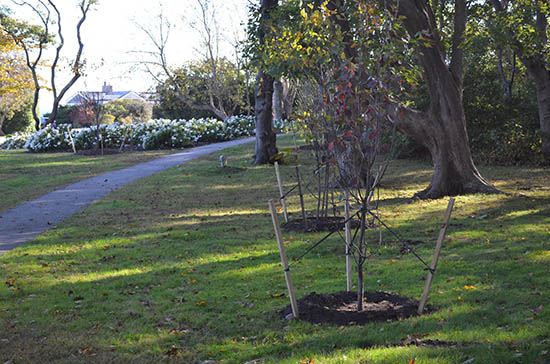As I like to say, Castle Hill is a miracle of nature: carved of stone and enveloped in water. We honestly could not do anything to enhance our water views or improve the spectacle of the setting sun as it plays out from our profound vantage point, but we are always striving to enhance the landscape, which is about to benefit from the planting of some new trees.

Historically, Newport has an interesting relationship with trees. In the aftermath of the Revolutionary War, the town was left completely bereft of trees and there were hardly any to be found across the entire island. After decades of being cut down for firewood, clearing for farmland, and the building of homes and ships, the final destruction came with the occupation of the British Navy during the War for American Independence. The town and the landscape were left in ruins. Newport experienced a severe depression that was not felt as harshly on the mainland and led to the ascendancy of Providence over Newport as the center of commerce in Rhode Island. Eventually Newport thrived as a resort, initially due to its natural beauty and soothing climate, and subsequently became the summer playground of the titans of the industrial age. But what about the trees?

A new fountain feature at Castle Hill is surrounded by mature trees.
The owners of the great estates, built on former farmland in the Bellevue Avenue and Ocean Drive districts, naturally wanted to enhance their landscapes with impressive trees. For the most part, just as their architecture was inspired by that of Europe, such was their taste in trees. The building boom of mansions in Newport just before and after the turn of the 20th century corresponded with a planting boom of thousands of specimen trees, mostly of European varieties, notably the European beech tree, which boasts several varieties of its own, including copper and weeping specimens. The American beech comes in only one variety but planted in its native soil has a better chance of living out its natural life cycle. The European beeches can live 300 years in their native climes. In Newport, many of those planted less than half that time ago have already succumbed. The copper variety seems to be the most susceptible, while the weeping variety has proven to be the most successful transplant, with many mature weeping beech trees still flourishing around town.

A newish American Beech tree at Castle Hill
Several of the largest and most mature beech trees at Castle Hill are the European variety. While we hope to enjoy them for many years to come, our new trees are all native varieties, including some good old American beech trees.

A mass of beech trees at Castle Hill

A baby beech joins the Castle Hill arboretum.

A good old American Basswood
In addition to our two new beech trees, we have planted:
3 new red maples, which just so happens to be the state tree of Rhode Island and the most abundant native tree in eastern North America!
3 flowering dogwood trees: Did you know that dogwood trees were exchanged with Japan for the famous cherry trees in Washington D.C.?

3 Winterberry, which produce lots of berries like holly but are not evergreens and do not have sharp leaves.

3 tulip trees, which can grow close to 200 feet and produce distinct flowers that resemble tulips!

A new Tulip Tree at Castle Hill with plenty of room to grow.
2 Eastern Redbuds, which produce showy clusters of pink flowers in Spring.
2 Sweetgum, that may rival the fiery red maples for fall color.
The new trees join the mature trees on either side of the approach that leads to the 1875 Agassiz mansion. The effect is the same today arriving by car as it was when visitors arrived by horse-drawn carriages, wherein the mansion and the view it affords aren’t revealed until you reach the top of the hill. We’ll see you there!
– Shea C Nelson
